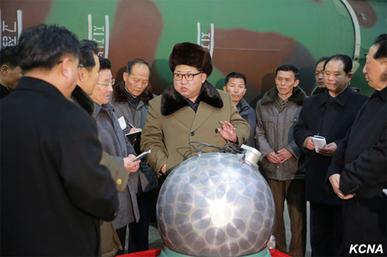 A miniaturized nuclear bomb suitable for firing from an ICBM. Credit: Wikimedia.
A miniaturized nuclear bomb suitable for firing from an ICBM. Credit: Wikimedia.
Addressing North Korea’s Growing Nuclear Challenge
Continuing media reports on North Korea’s recent missile tests indicate an unusually high rate of testing in 2022. Despite sanctions, Pyongyang has recently conducted yet another missile test, making it the country’s seventh consecutive test since the beginning of the year, and the “longest-range missile since 2017,” capable of carrying a nuclear warhead. These tests and the country’s nuclear program pose major challenges to the U.S. and its allies, particularly South Korea and Japan, not to mention the global nuclear nonproliferation regime.
At present, North Korea is believed to have 25-50 nuclear warheads. It withdrew from the NPT in 2003 and has since conducted six nuclear tests. Negotiations with the U.S. have been on hold since 2019, and diplomatic efforts to denuclearize the country have so far been unsuccessful. Meanwhile, North Korea continues to develop its nuclear and missile capabilities, violating several UN Security Council resolutions barring it from all ballistic missile and nuclear weapons tests.
Just last month, the country tested several different types of weapons:
- It conducted two hypersonic missile tests on January 5 and 11, with the latter being more advanced and capable of exceeding Mach 10.
- It further conducted two short-range ballistic missile (SRBM) tests each on January 14 and 17. The January 14 test appeared to be a KN-23 SRBM, first tested in May 2019. The January 17 launch appeared to be KN-24 SRBM, which was last tested in March 2020 and is similar to the U.S. Army’s MGM-140 Army Tactical Missile System (ATACMS).
- Two long-range cruise missiles were launched on January 25, which flew 1,800 km before hitting a target island in the sea off North Korea’s east coast. This was followed by two tactical guided missiles tested on January 27.
- It reportedly conducted its seventh test this Sunday, which appeared to be of a Hwasong-12, an intermediate-range ballistic missile (IRBM). The missile flew about 800 km and reached a maximum altitude of 2,000 km before crashing into the sea to the east of North Korea. This North Korean IRBM is said to be a single-stage design, with the ability to carry a nuclear warhead. It has a 500 kg payload, an estimated range of 4,500 km, and could reach the U.S. Pacific Island of Guam. First successfully tested in 2017, this missile has since been tested several times.
Though not tested so far this year, Pyongyang has two other missiles capable of targeting the U.S.:
- Hwasong-14 – This North Korean intercontinental ballistic missile (ICBM), with a range of over 10,000 km and a 500 kg payload, is a two-stage, liquid-fueled missile that was first successfully flight-tested in 2017. It is capable of striking targets in the Western U.S.
- Hwasong-15 – This North Korean ICBM, also first tested in 2017, is considered the largest and most powerful missile the country has. It is a two-stage, liquid fueled system and has a range of 8,500-13,000 km, making it capable of reaching the U.S. mainland. Both the Hwasong-14 and -15 were the country’s first ICBM tests.
Despite the recent flurry of tests, North Korea’s goal is still self-preservation, and it only seeks to appear more threatening in order to deter military action against it and to gain concessions in any future talks. In this case the tests are useful bargaining chips.
North Korea’s negotiating goals have long included an internationally guaranteed peace treaty to officially end the Korean War. The U.S. missed an opportunity decades ago, when North Korea was developing nuclear weapons but before any were tested, to offer such a peace treaty, thereby providing guarantees against a U.S.-supported invasion from the South. This might have satisfied their major demands, especially when Kim Jong Un’s father was still alive and in charge. That is far more difficult now. The tests reflect the country’s latest technological advances, and, while North Korea’s nuclear capability cannot be undone, now it can only be managed through potential arms control agreements. An end-of-war declaration now is unlikely to persuade Kim to dismantle his nuclear arsenal, but it could decrease the threat that north Korea feels and decrease the frequency or likeliness that it will conduct these tests or engage in other aggressive behaviors.
North Korea’s recent missile tests indicate that the country is looking to further improve its missile and nuclear warfare capabilities to bolster its deterrence strategy, while building leverage for future talks that will allow it to negotiate from a position of strength to secure its regime. At the same time, based on his 2021 “five-year plan” Kim not only wants a qualitative arms modernization but also plans to expand his nuclear arsenal, with some already developed, and others “currently in development.” Although it does not want a war, knowing it has no chance of winning, North Korea’s actions worry its neighbors. To mitigate the threat posed by North Korea’s growing nuclear challenge, the U.S. should work with its allies to find ways to significantly lower tensions. Although internationally isolated and heavily sanctioned, Pyongyang will not abandon its nuclear program. Therefore, realistic, and mutually acceptable solutions should be proposed to promote stability in the region. In doing so, Kim must show his willingness to curb further development in exchange for limited sanctions relief.





